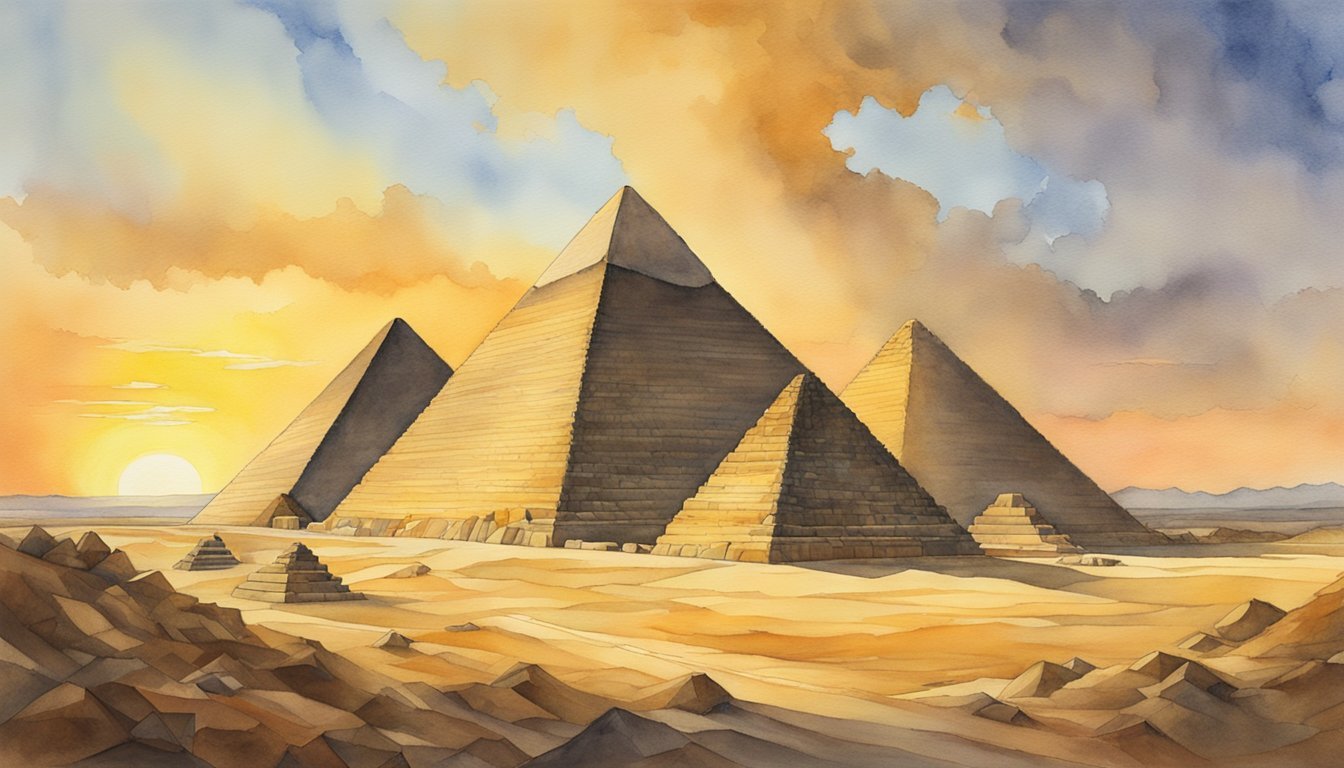Historical Significance and Creation
The Seven Wonders of the Ancient World capture the ingenuity and grandeur of civilizations past. Through a blend of human achievement and artistic prowess, these monuments span continents and have shaped our modern perception of ancient history.
Conceptualization and Recognition
The concept of the Seven Wonders of the Ancient World was recognized by Hellenic travelers and scholars like Herodotus and Callimachus of Cyrene, who sought to document the greatest human-made structures of their time. Lists of these marvels, known as “theamata” in Greek, varied until writers like Philo of Byzantium provided a definitive enumeration, which has been widely accepted.
Cultural and Geographic Span
The wonders excelled in representing a diverse cultural and geographical span, stretching from the Mediterranean to the heart of the Middle East. These extraordinary structures included the Great Pyramid of Giza in Egypt, the Hanging Gardens of Babylon in present-day Iraq, and the Statue of Zeus at Olympia in Greece, each contributing a unique testament to the civilizations which built them.
Influence on Modern Perception
The lofty achievements of the Seven Wonders have heavily influenced our modern perception of the ancient world. These architectural feats have become synonymous with the pinnacle of ancient ingenuity, serving to measure contemporary achievements against those of our ancestors.
Documentation and Literary References
Revered writers of antiquity such as Antipater of Sidon and Strabo, as well as later historians like Diodorus Siculus, painstakingly documented these wonders in their writings, contributing largely to the preservation of their legacy. Many such accounts can be found in the Greek Anthology.
Destruction and Conservation Efforts
Natural disasters like earthquakes and human-induced destruction led to the demise of six of the wonders, leaving only the Great Pyramid of Giza intact. Efforts to conserve these and other ancient sites continue, as in the case of the British Museum, which houses significant artifacts from around the world.
Tourism and Educational Importance
Today, the remaining wonders and their ruins draw millions of tourists yearly. They serve as important educational tools, offering insight into ancient Mediterranean, European, and Asian civilizations, and highlight the unifying capacity of human creativity across time and space.
Individual Wonders and Their Marvels

The Seven Wonders of the Ancient World represent some of the most remarkable achievements in architecture and engineering from ancient civilizations. Each wonder showcases the ingenuity and skill that ancient builders employed to create structures that would stand the test of time.
Great Pyramid of Giza
The Great Pyramid of Giza, constructed under the rule of Pharaoh Khufu, is a testament to the extraordinary architectural prowess of the ancient Egyptians. Consisting of approximately 2.3 million stone blocks transported from nearby quarries, this pyramid not only served as a tomb for Khufu but also demonstrated the Egyptians’ precise understanding of astronomy and geometry.
Hanging Gardens of Babylon
Attributed to King Nebuchadnezzar II, the Hanging Gardens of Babylon are famed for their intricate irrigation systems that allowed flowers and fruits to flourish in the heart of the Middle East. Considered a marvel of engineering, details of its exact construction remain a mystery, with some scholars even questioning its existence.
Statue of Zeus at Olympia
Crafted by the sculptor Phidias, the Statue of Zeus at Olympia was a colossal ivory and gold statue that stood in the Temple of Zeus. This grand representation of the god Zeus embodied ancient Greek artistic skills, as the statue was richly decorated with sculptures and paintings, causing all who viewed it to marvel at its splendor.
Temple of Artemis at Ephesus
The Temple of Artemis at Ephesus, dedicated to the Greek goddess Artemis, was renowned for its grandeur and magnificent columns. Notably rebuilt after being destroyed by arson committed by Herostratus, the temple is remembered not just for its size but for the art that adorned its whole structure.
Mausoleum at Halicarnassus
Erected as a tomb for Mausolus, a Persian satrap, the Mausoleum at Halicarnassus reflected intricate design elements combining Greek, Egyptian, and Persian art influences. This structure, featuring a series of statues and elevated on a large stepped platform, was so admired that Mausolus’s name became synonymous with grand tombs.
Colossus of Rhodes
The Colossus of Rhodes was a massive statue dedicated to the sun god Helios. Designed by Chares of Lindos, this wonder of the ancient world stood over 30 meters tall and symbolized the triumph of the Rhodians over the ruler Alexander the Great.
Lighthouse of Alexandria
Serving as both a landmark for navigation and a symbol of Hellenistic Alexandria, the Lighthouse of Alexandria, also known as Pharos, was one of the tallest structures of its time. Its mirror, which reflected the sun’s light, could be seen from miles away; this innovation was paramount in aiding the safe return of sailors to the Mediterranean’s bustling ports.

